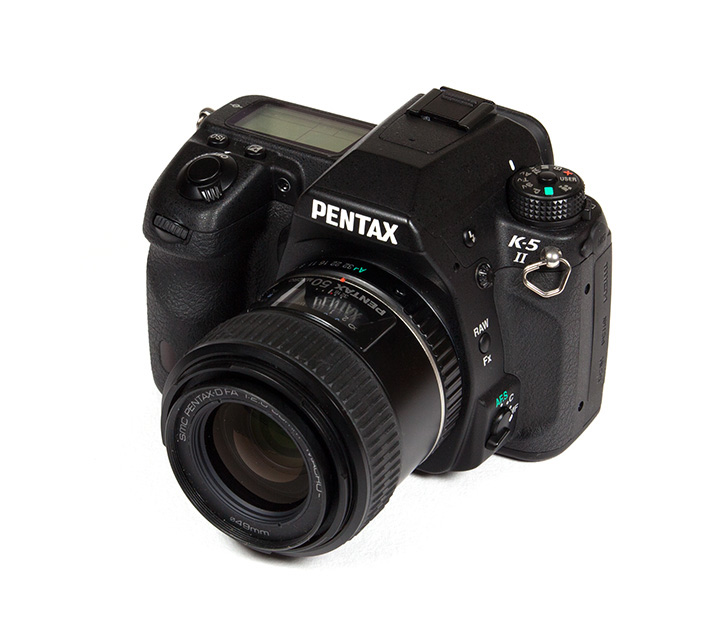|
Pentax D FA 50mm f/2.8 macro - Review / Test Report |
|
Lens Reviews -
Pentax
|
|
Page 1 of 3

Review by Klaus Schroiff, published June 2015
Introduction
When it comes to dedicated macro lenses, buyers have the choice between a variety of different focal length classes with their distinctive pros and cons. In this review we will discuss a representative of the "standard" category - the Pentax SMC D-FA 50mm f/2.8 macro. Just like most 50mm macro lenses, it is very compact, light-weight and affordable. Being a full format lens, it was a bit of an exception to the rule at a time when Pentax centered their strategy around the APS-C format. However, from today's perspective that was almost a fortunate decision regarding Pentax' upcoming full format camera.
 Introduced back in 2004, the D-FA 50mm f/2.8 macro follows a different design language compared to contemporary Pentax lenses but the styling alone is probably a lesser aspect to worry about for most. While it has a metal mount, most of the body is made of plastics and, unfortunately, the used materials feel a little cheap here. The situation gets even worse when focusing towards the macro distances. The lens uses duo cams, thus two inner lens tubes, that can extend quite a bit. That alone is no problem per se. However, the whole mechanism is wobbly. Manual focusing feels reasonably smooth. If you prefer a tighter focus action you can use a focus clamp to increase the friction.
Introduced back in 2004, the D-FA 50mm f/2.8 macro follows a different design language compared to contemporary Pentax lenses but the styling alone is probably a lesser aspect to worry about for most. While it has a metal mount, most of the body is made of plastics and, unfortunately, the used materials feel a little cheap here. The situation gets even worse when focusing towards the macro distances. The lens uses duo cams, thus two inner lens tubes, that can extend quite a bit. That alone is no problem per se. However, the whole mechanism is wobbly. Manual focusing feels reasonably smooth. If you prefer a tighter focus action you can use a focus clamp to increase the friction.
 The D FA 50mm f/2.8 macro has no internal AF motor and relies on a slotted drive screw operated by the camera. While this is no real issue for most conventional lenses, this generic approach is not the best solution for a macro lens with its potentially long focus path. Consequently it takes quite a while to auto-focus from infinity towards 1:1 magnification. In other words - the AF is a slow, prone to hunting and also fairly noisy. A focus limiter could have helped but it was omitted. On the plus side, the lens features a Quick-Shift mechanism for manual focusing in AF mode. Typical for 50mm macro lenses, there is also a bit of a practical limitation - at max. magnification (1:1) it has a working distance (front element to object distance) of less than 5cm. If you are into nervous critters, you will run into issues here at times.
The D FA 50mm f/2.8 macro has no internal AF motor and relies on a slotted drive screw operated by the camera. While this is no real issue for most conventional lenses, this generic approach is not the best solution for a macro lens with its potentially long focus path. Consequently it takes quite a while to auto-focus from infinity towards 1:1 magnification. In other words - the AF is a slow, prone to hunting and also fairly noisy. A focus limiter could have helped but it was omitted. On the plus side, the lens features a Quick-Shift mechanism for manual focusing in AF mode. Typical for 50mm macro lenses, there is also a bit of a practical limitation - at max. magnification (1:1) it has a working distance (front element to object distance) of less than 5cm. If you are into nervous critters, you will run into issues here at times.
| Specifications |
|---|
| Optical construction | 8 elements in 7 groups |
| Number of aperture blades | 8 |
| min. focus distance | 0.195m (max. magnification ratio 1:1) |
| Dimensions | 60x67.5mm |
| Weight | 265g |
| Filter size | 49mm (non-rotating) |
| Hood | barrel-shaped, bayonet mount, supplied |
| Other features | macro, Quick-Shift, focus clamp |
|